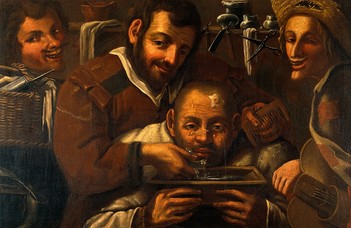Healing Professions Workshop II.
Summary of Judit Kis-Halas' presentation

From witches to county physicians. Healing professionals in the new marketplace of medicine (Lessons from a medical anthropological study of the history of professionalisation)
In recent years I have been studying the coexistence of folk, sacral and learned systems of medicine in the 17th and 18th centuries. I wanted to assert the perspective of the agents of healing, so I focused my attention on their stories of illness and healing. To do this, I juxtaposed the testimonies of the witch trials with the manuscript records of miracles from the shrine of St. Mary of the Assumption. The area of influence of the shrine of Mariagyűd, from where the beneficiaries of the miracles came, extended east-west from Kalázne to Nagykanizsa, north-south from the southern shore of Lake Balaton to Novi Sad, and roughly covered the area of the then counties of Baranya, Tolna, Somogy, Zala, Bács and Valpó. From here, a total of 312 miraculous cures have been recorded, mostly dating back to the 18th century. From the same period and from the same area, 144 witch trials are known.
In addition to the medical literature of the period, I have used archival sources relating to public healing (including guild records, town account books and council minutes, medical and surgical inventories, plague epidemic records), as well as 18th century records from the Franciscan communities that pastored the shrine. These include collections of sermons, ritual, prayer and hymn books, and devotional and theological works relating to the former libraries of the monasteries.
My study largely provides a picture of the period immediately preceding the institutionalisation of health care in the 18th century (medicalisation) and the process of professionalisation of the healing professions, but it also goes beyond this by predicting the regional trends and later development of this process. In addition to presenting contemporary medical knowledge and describing the experience of illness, I have focused on the key figures in the market for healing, i.e. the professionals who practised it. The nearly one hundred midwives, javelins, scholars, bathers, barbers, barber-surgeons, military and plague-keepers, apothecaries and physicians whose activities are recorded in varying degrees of detail in the sources. The number of formally trained practitioners was small, but some of them are recorded as having considered medicine as a genuine vocation. The following is a discussion of barbers, surgeons and bathers who practised medicine in a corporate context, i.e. within the guild.
Barbers and witchcraft
Barbers, bathers and barber-surgeons were authorised by their qualifications and the professional rules laid down in the guild regulations to practise only mechanical remedies on the human body. They could only use external treatments, i.e. ointments, tinctures, poultices, plasters, baths, cutting a vein, repairing a dislocation, extracting teeth and performing surgery. They also, of course, cut hair and beards. They were not allowed to administer medicines internally without a doctor's recommendation and were obliged to consult a doctor in cases requiring internal treatment or in complicated cases.
In the documents of witchcraft examined here, however, there are only a few references to barbers or barber-surgeons (kirurgus). Only one of them is known by name: János Herczell, a surgeon from Zalaegerszeg. There is also an unnamed barber from Székesfehévár (1717), Nagykanizsa (1720), Varazdin (1743), Türje, Felcsány and Nagykutas (1764).
The barbers had two approaches to witchcraft: either they accepted this interpretation of the disease and acted accordingly, i.e. they identified the witch and "cured" her, or they rejected the explanation of witchcraft, came up with another one and treated the patient accordingly. The former version is mentioned in the testimony of Ferenc Takács of Nagykutasi (Zala county), recorded in 1764, who stated that for a whole month he was "neither allowed to lie down nor to stand", but "had to sit on the bed and lie on the bed". When he finally took himself to the 'nurse', she informed him that it was 'Eörse Bankics [the woman accused of witchcraft] who would have done it to him'. The other situation was discussed in court in 1735 by János Herczell, a surgeon from Zalaegerszeg. He told how when László Törjék, who was allegedly suffering from witchcraft, was "brought under his curia", he told him clearly that "his health was not corrupted by diabolical arts, but he was whole in hectic." The barber from Székesfehérvár, whom Mihály Góber from Paks had approached with his problem, did the same thing: he cut his throat, although Góber was convinced that he had been corrupted.
The legitimacy of medical practice was already a key issue in the accusation of witchcraft, since the suspicion of superstitious (i.e. illegal) medicine was cast on folk healers, and primarily on them. They did not learn the art of medicine in a corporate setting, like bathers and barbers. The authorities were particularly interested in the source of the healers' knowledge, and the accused - for understandable reasons, since their lives were often at stake - tried to meet the expectations. This is why they might have made a barber or barber-surgeon their master.
This was the case, for example, in 1735, with Mrs Gyurisic, a Serbian healer and midwife from Tovarosova, who insisted, even in her testimony recorded during the torture trial, that the thirty-five (!) herbs she knew had been taught to her by her barber-surgeon grandfather (avus hujus fatentis ante chyrurgus fuit) from her early childhood (ab ipso in pueritia). In 1751, the Franciscan monk Mihály Szvetics from Pula in Istria, who had been expelled, argued in a similar way at the seat of the Bishop of Pécs. When he applied to the bishop for a hospital post, he stressed that he had worked for years as an assistant to a doctor of medicine in Venice, and that this was how he had acquired his healing knowledge.

